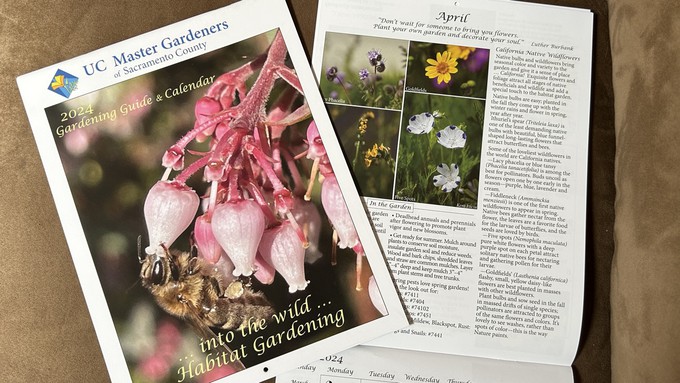
'Habitat Gardening' is the theme for the latest publication

The 2024 Gardening Guide & Calendar debuts Saturday at Harvest Day. Kathy Morrison
The Sacramento County master gardeners' Harvest Day event not only is a celebration of the current gardening year, it also brings a subtle reminder that the 2024 gardening year is not that far off.
That's because the next Gardening Guide & Calendar goes on sale for the first time during Harvest Day, this Saturday, Aug. 5, from 8 a.m. to 2 p.m. The new price for this invaluable publication is $12, slightly higher than in previous years to cover increased costs. But it's still a bargain, stuffed with monthly gardening tips, a Sacramento planting guide and lists of websites to UC research-based gardening information.
The theme of the 2024 publication is " ... into the wild ... Habitat Gardening," defined as plantings that feed, shelter and otherwise benefit insects, birds and other wildlife. Each month's calendar pages features information on important plants for wildlife -- from oaks in January to winter berries in December -- while the back section goes into more detail on how to "habitat garden." Here's a sample:
"Creating a habitat garden can be as simple or as complicated as you want, and can be done on any size lot. Convert a traditional landscape to attract and support wild creatures. All, like us, need food, shelter and water to survive. Habitat gardening will provide all of those whether we have a large garden, a strip of yard or a sunny porch."
The Gardening Guide & Calendar features gorgeous plant pictures, many by local master gardeners Jan Fetler, Roxie Jones, Greta Lacin, Pam Bone and Pat Schink. Edited by Laura Cerles-Rogers, it's written by Sacramento master gardeners for Sacramento-area gardens. (Full disclosure: I'm also a contributor to the publication.)
As usual, the Gardening Guide & Calendar will be available soon at area retailers and online, but the debut sale is always at Harvest Day -- with the added incentive of no tax or shipping costs.
Harvest Day takes place at the Fair Oaks Horticulture Center, 11549 Fair Oaks Blvd. in Fair Oaks, just south of Madison Avenue. For more on Harvest Day, which has both free admission and parking, see our other blog posts this week or go to https://sacmg.ucanr.edu/Harvest_Day/
Comments
0 comments have been posted.Sacramento Digs Gardening to your inbox.
Food in My Back Yard Series
May 6: Maintain soil moisture with mulch for garden success
April 29: What's (already) wrong with my tomato plants?
April 22: Should you stock up on fertilizer? (Yes!)
April 15: Grow culinary herbs in containers
April 8: When to plant summer vegetables
April 1: Don't be fooled by these garden myths
March 25: Fertilizer tips: How to 'feed' your vegetables for healthy growth
March 18: Time to give vegetable seedlings some more space
March 11: Ways to win the fight against weeds
March 4: Potatoes from the garden
Feb. 25: Plant a fruit tree now -- for later
Feb. 18: How to squeeze more food into less space
Feb. 11: When to plant? Consider staggering your transplants
Feb. 4: Starting in seed starting
Sites We Like
Garden Checklist for week of May 11
Make the most of the lower temperatures early in the week. We’ll be back in the 80s by Thursday.
* Plant, plant, plant! It’s prime planting season in the Sacramento area. Time to set out those tomato transplants along with peppers and eggplants. Pinch off any flowers on new transplants to make them concentrate on establishing roots instead of setting premature fruit.
* Direct-seed melons, cucumbers, summer squash, corn, radishes, pumpkins and annual herbs such as basil.
* Harvest cabbage, lettuce, peas and green onions.
* In the flower garden, direct-seed sunflowers, cosmos, salvia, zinnias, marigolds, celosia and asters. (You also can transplant seedlings for many of the same flowers.)
* Plant dahlia tubers.
* Transplant petunias, marigolds and perennial flowers such as astilbe, columbine, coneflowers, coreopsis, dahlias, rudbeckia and verbena.
* Keep an eye out for slugs, snails, earwigs and aphids that want to dine on tender new growth.
* Feed summer bloomers with a balanced fertilizer.
* For continued bloom, cut off spent flowers on roses as well as other flowering plants.
* Add mulch to the garden to maintain moisture. Mulch also cuts down on weeds. But don’t let it mound around the stems or trunks of trees or shrubs. Leave about a 6-inch-to-1-foot circle to avoid crown rot or other problems.
* Remember to weed! Pull those nasties before they set seed.
* Water early in the day and keep seedlings evenly moist.